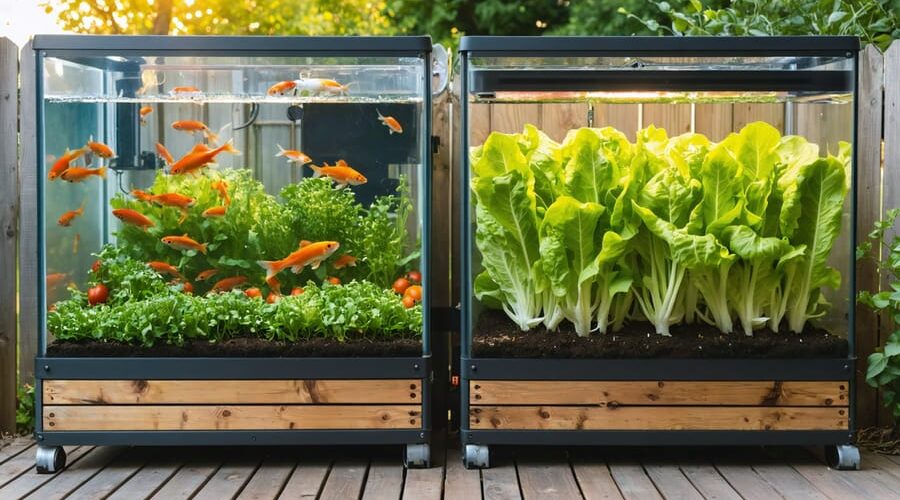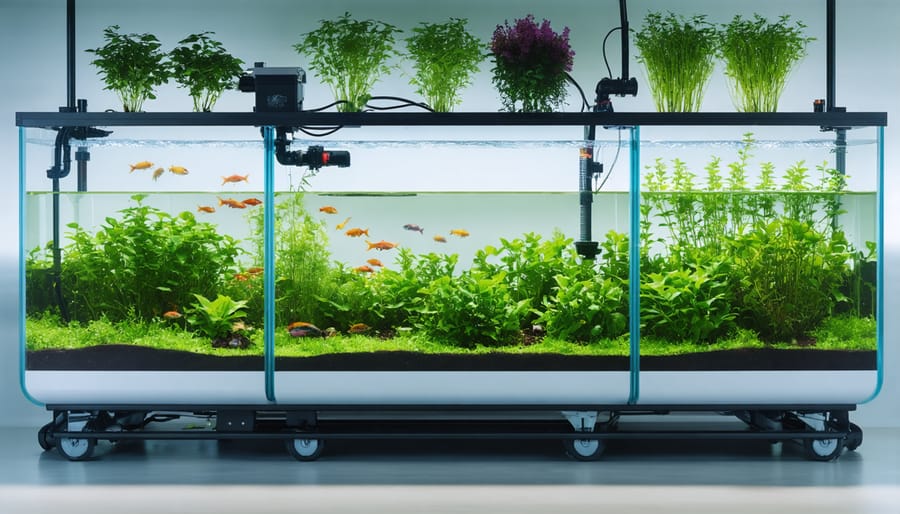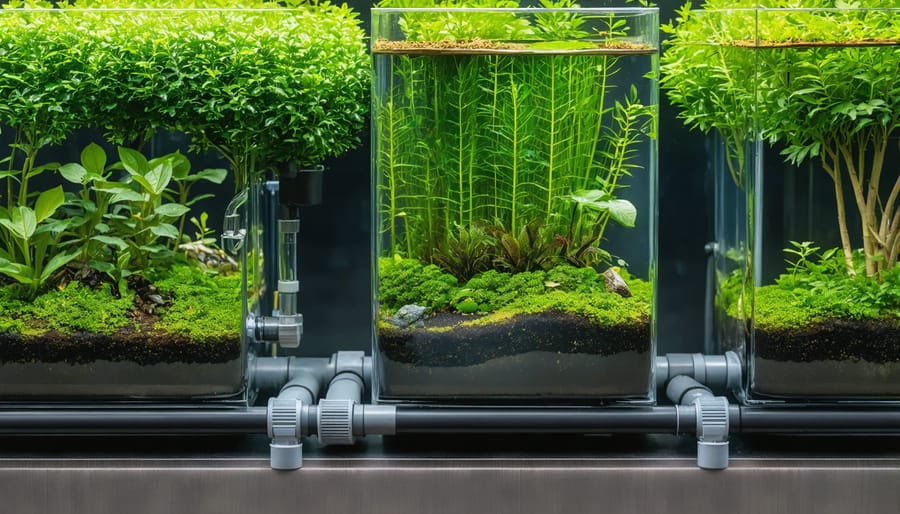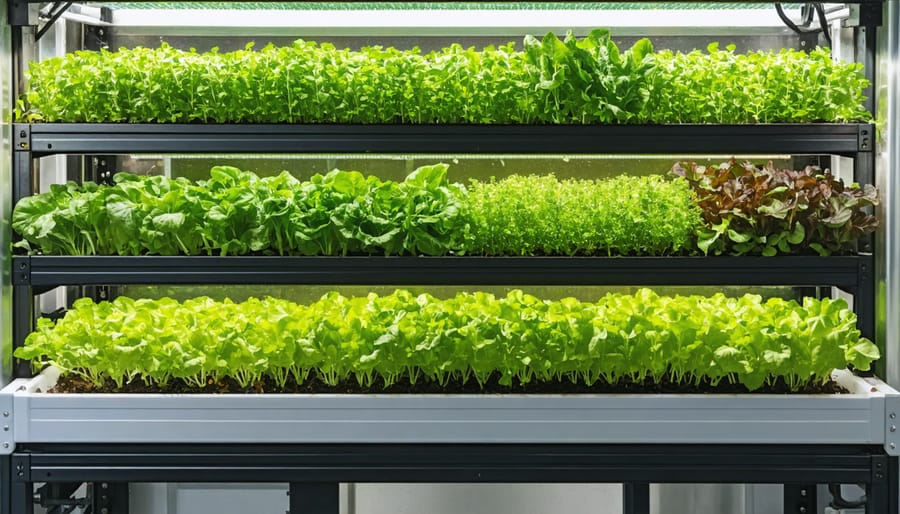
Why Decoupled Aquaponic Systems Actually Work Better (And How to Build One)
Imagine harvesting crisp lettuce and plump tomatoes while your koi swim peacefully below—all in a system that practically runs itself. That’s the magic of decoupled aquaponic system (DAPS) design, and it’s changing the game for backyard growers everywhere.
Unlike traditional aquaponics systems where your fish and plants share the same water loop, DAPS gives you independent control over each environment. Think of it as having two interconnected systems that work together but can be adjusted separately—your fish get their ideal water conditions while your plants get exactly what they need to thrive. No more compromising between what your fish can tolerate and what your vegetables demand.
The beauty of this approach? You can dial in precise nutrient levels for your plants without worrying about stressing your fish. Your water temperature can stay perfect for goldfish while your strawberries get the cooler root zone they crave. And if something goes wrong in one system, the other keeps running smoothly.
Whether you’re converting an existing pond into a food-producing powerhouse or starting fresh with a new setup, designing a DAPS puts you in the driver’s seat. You’ll maintain healthier fish, grow more productive plants, and spend less time troubleshooting problems. Ready to build a system that works with you, not against you? Let’s dive into the essentials of DAPS design.
What Makes DAPS Different from Traditional Aquaponics

The Three-Loop System Explained Simply
Think of a decoupled aquaponic system like a well-choreographed dance between three partners, each with their own rhythm but moving to the same beautiful music.
**The fish loop** is where your finned friends live their best life. Water circulates from your pond through a filter system that removes solid waste, then returns clean and oxygen-rich back to the fish. This loop runs continuously, keeping your pond environment stable and healthy—just like the natural circulation in a pristine lake.
**The plant loop** operates on its own schedule, typically running intermittently throughout the day. Nutrient-rich water from the system feeds your grow beds where vegetables and herbs thrive. Here’s the magic: beneficial bacteria convert fish waste into plant food (nitrogen, specifically). After the plants absorb what they need, the cleaned water flows onward. I like to think of plants as nature’s water purifiers—they’re doing the heavy lifting while producing your dinner!
**The shared sump** is the connector—the meeting point where both loops come together. This reservoir collects water from both systems and redistributes it where needed. It’s also your control center for adjusting water levels and monitoring overall system health.
By keeping these loops separate yet connected, you get the best of both worlds: happy fish in pristine conditions and thriving plants that clean the water naturally. No complicated timing required—each loop operates independently while contributing to the whole ecosystem.
Why Separation Gives You More Control
One of the biggest “aha” moments I had with decoupled aquaponics was realizing I could finally stop playing the impossible balancing game. You see, fish are happiest in water with a pH around 6.5-7.5, while most plants thrive in slightly more acidic conditions, around 5.5-6.5. In traditional aquaponics, you’re stuck compromising somewhere in the middle, and honestly, neither your fish nor your plants are truly thriving.
With a decoupled system, you’re the master of both worlds. Want to adjust the nutrient concentration for your leafy greens without stressing your koi? Go right ahead. Need to treat a minor fish ailment without worrying about harming your tomato plants? No problem.
Here’s what you gain practical control over:
**pH levels** – Keep fish water neutral while acidifying your plant beds for optimal nutrient uptake. I adjust mine independently every few days, and both systems are healthier for it.
**Nutrient concentration** – Fish produce nutrients slowly and inconsistently. With separation, you can supplement your plant beds with exactly what they need, when they need it.
**Water temperature** – Some plants prefer cooler conditions while your fish might need warmer water. Decoupling lets you optimize each environment separately.
**Troubleshooting** – When something goes wrong, you’re isolating the problem to one system instead of risking everything at once. It’s like having a safety net that’s saved my setup more than once.
Planning Your Decoupled Aquaponic System
Sizing Your System to Your Space
Getting the size right is absolutely crucial for your aquaponic success, and the good news is that these systems are incredibly flexible! Whether you’re working with a cozy apartment balcony or a spacious backyard, you can design something that fits perfectly.
Start by measuring your available space—and I mean really measuring it. Don’t forget to account for walkways around your system for maintenance. You’ll need comfortable access to feed fish, harvest plants, and check water levels. I learned this the hard way when I squeezed a system into a tight corner and ended up doing acrobatics just to reach the fish tank!
For beginners, I always recommend starting smaller than you think you need. A 50-100 gallon fish tank paired with 8-16 square feet of grow beds is wonderfully manageable and teaches you the ropes without overwhelming you.
Here’s a helpful ratio to remember: aim for a 1:1 ratio between your fish tank volume and grow bed volume. So if you have a 100-gallon fish tank, you’ll want about 100 gallons of grow bed space (roughly 12 square feet at 8 inches deep).
Consider vertical space too! Patios and small yards benefit tremendously from vertical towers or stacked grow beds. Greenhouses offer climate control advantages but require ventilation planning. Outdoor systems need shade considerations—full sun can overheat your fish, while too much shade limits plant growth. Map out sun patterns before committing to placement.
Choosing Fish and Plants That Work Together
The magic of aquaponics really comes alive when you match the right fish with the right plants. Think of it like creating a small ecosystem in your backyard—everything needs to work in harmony!
**Starting Simple with Fish**
If you’re just dipping your toes into aquaponics, tilapia are fantastic beginner fish. They’re hardy, grow quickly, and tolerate varying water conditions like champs. I remember my first system—those tilapia thrived despite my rookie mistakes! Goldfish are another excellent starter option, especially if you’re not planning to harvest fish for eating. They’re incredibly resilient and add beautiful color to your system. For those wanting something more ornamental, koi bring elegance and can grow quite large, though they need more space and better filtration.
**Picking Your Plants**
Start with leafy greens like lettuce, spinach, and kale—they’re the easiest plants for aquaponics and grow impressively fast. You’ll be harvesting salads within weeks! Herbs like basil, mint, and cilantro also flourish in these systems and love the constant nutrient supply. Once you’ve gained confidence, tomatoes, peppers, and cucumbers are exciting next steps, though they require more nutrients and careful monitoring.
**The Perfect Pairing**
Here’s the secret: match your fish load to your plants’ appetite. Heavy feeders like tomatoes need more fish waste, so plan for a higher fish density. Leafy greens are more forgiving and work beautifully with smaller fish populations. Temperature matters too—if your fish prefer warmer water, choose heat-loving plants like basil and tomatoes. Cooler water? Lettuce and other greens will be happier companions.

Essential Components for Your DAPS Setup
The Fish Tank: Your Aquatic Foundation
Your fish tank is truly the heart of your aquaponic system—it’s where all the magic begins! When I built my first system, I learned quickly that choosing the right tank makes everything else fall into place more smoothly.
For size, plan on at least 50-100 gallons for a starter system. This gives your fish enough swimming room and creates a stable environment that’s forgiving of beginner mistakes. Larger volumes mean water conditions stay more consistent, which keeps both fish and plants happier.
Material-wise, you’ve got options! Food-grade plastic stock tanks are affordable and durable—my personal favorite for outdoor setups. IBC totes (those big cube containers) work wonderfully and are often available secondhand. Avoid metal tanks unless they’re specifically lined, as they can leach harmful substances into your water.
Placement is key: choose a spot that’s level, receives adequate sunlight for your plants, and provides easy access for feeding and maintenance. I can’t stress enough how much easier life gets when you can comfortably reach your system! Keep it near a water source for topping off, and consider shade cloth if you’re in a hot climate to prevent overheating.
Grow Beds and Hydroponic Options
Your grow beds are where the magic happens – where plants transform fish waste into lush greenery! Let’s explore three popular options that work beautifully in aquaponic systems.
**Media beds** use expanded clay pebbles or gravel to support plant roots. They’re fantastic for beginners because they filter water naturally and support almost any plant type, from lettuce to tomatoes. The downside? They’re heavier and need more space than other methods.
**NFT growing methods** (Nutrient Film Technique) flow a thin film of water through channels where plants sit in net pots. Perfect for leafy greens and herbs, NFT systems are space-efficient and lightweight. However, they’re less forgiving if pumps fail, and larger fruiting plants won’t thrive here.
**Deep Water Culture (DWC)** floats plants on rafts over nutrient-rich water. Commercial growers love DWC for its simplicity and fast growth rates. It’s excellent for lettuce and leafy crops but requires good aeration and works best for smaller, quick-growing plants.
I started with media beds in my first system – they’re wonderfully forgiving while you learn!
The Sump Tank: Your System’s Control Center
Think of your sump tank as mission control for your aquaponic system—it’s where everything comes together! In a DAPS setup, the sump sits below your grow beds and fish tank, collecting water from both before pumping it back through the system. This clever design gives you one central spot to monitor water levels, adjust pH, and add supplements.
Here’s a handy rule I’ve learned through trial and error: size your sump to hold at least 20-30% of your total system volume. This extra capacity acts as a safety buffer when grow beds drain or pumps cycle off. For example, if you’re running a 500-gallon system, plan for a 100-150 gallon sump.
The beauty of the sump is stability. When water levels fluctuate in your fish tank or grow beds, the sump absorbs those changes, keeping everything balanced. Plus, having your pump in the sump instead of the fish tank means less disturbance to your finned friends!
Pumps, Filters, and Water Movement
Getting water moving properly through your decoupled aquaponic system is easier than you might think! Your pump is the heart of the operation, and sizing it correctly makes all the difference. For most backyard systems, you’ll want a pump that circulates the fish tank water at least once per hour. I learned this the hard way when my first undersized pump left my fish gasping—not a mistake you want to repeat!
Choose a reliable submersible pump rated for continuous operation. Look for energy-efficient models that won’t spike your electricity bill. For filtration, you’ll need mechanical filtering (like filter pads or brushes) to catch solid waste before it clogs your system, plus biological filtration where beneficial bacteria break down ammonia. Many pond filters handle both jobs beautifully.
Water circulation between your decoupled fish and plant systems can be as simple as gravity-fed drains and strategically placed pumps. The key is maintaining steady flow without creating dead zones where debris accumulates. Test your circulation by dropping food coloring in different spots—you’ll quickly see where water moves well and where it stagnates.
Building Your System: A Step-by-Step Approach
Setting Up the Foundation
Before you introduce your first fish or plant, let’s talk about creating a solid foundation—literally! I learned this the hard way when my first system developed a slight tilt, causing water to pool in one corner. Trust me, starting level saves headaches later.
Begin by choosing a location with access to electricity and water, ideally with some shade protection during peak summer hours. Your fish tank and grow beds need remarkably level surfaces—we’re talking within a quarter-inch. Use a long carpenter’s level and shims or compacted gravel to achieve this. A sturdy base like concrete pavers, a reinforced deck, or compacted gravel works beautifully.
Think through your workflow before positioning components. Place your fish tank where you can easily feed and observe your aquatic friends daily. Position grow beds at a comfortable working height—your back will thank you during harvest time! Keep your biofilter and sump tank accessible for maintenance but out of the main traffic flow.
Consider future access needs too. Leave space around equipment for filter cleaning, pump maintenance, and those inevitable adjustments we all make as our systems evolve. A well-planned layout makes the daily joy of aquaponics even more rewarding!
Connecting Your Three Loops
Now for the exciting part – let’s connect everything together! Think of your plumbing as the circulatory system of your aquaponics setup, keeping everything flowing smoothly.
Start with your fish tank. You’ll need a bulkhead fitting near the bottom (about 2-3 inches from the base) that connects to PVC pipe leading to your grow beds. Gravity does the heavy lifting here – water flows downward naturally from the tank through this pipe. I remember drilling my first bulkhead hole and double-checking measurements about five times. Trust me, measure twice, drill once!
From your fish tank, water travels to your grow beds. If you’re using flood-and-drain beds, you’ll need a bell siphon or timer-controlled valve to manage the water level. The water enters at one end, floods the bed to feed your plants, then drains through another bulkhead at the bed’s base.
Here’s where your sump tank becomes your best friend. All that drained water from the grow beds flows downward (again, gravity for the win!) into the sump. Position your sump lower than everything else – this gives you natural flow and acts as a safety buffer if something clogs.
Finally, place a pump in your sump tank to push water back up to the fish tank. This completes your loop! Use flexible tubing or PVC for this return line. I prefer clear tubing for the return because you can see if anything’s blocking the flow.
Pro tip: Install ball valves at key points in your system. They let you control flow rates and make maintenance so much easier. You’ll thank yourself later when you need to isolate sections for cleaning!

Installing Monitoring and Control Systems
One of my favorite upgrades I’ve made to my aquaponic system was adding simple monitoring tools—it transformed my daily routine from guesswork to confident management. Let’s talk about making your system easier to manage without breaking the bank.
Start with the basics: a reliable timer for your water pump. You’ll want one that cycles water at appropriate intervals—I typically run mine for 15 minutes every hour during the day. Digital timers offer more flexibility than mechanical ones and usually cost under $20. This simple addition means you’re not manually switching pumps on and off throughout the day.
Temperature monitoring is your next priority. Grab an aquarium thermometer for around $5—those floating glass ones work perfectly. Fish thrive in specific temperature ranges, and knowing your water temp helps you troubleshoot problems before they become serious. I check mine each morning with my coffee.
For slightly more investment, consider a water testing kit that covers pH, ammonia, nitrites, and nitrates. Test weekly at first, then monthly once your system stabilizes. Keep a simple notebook to track readings—patterns emerge that help you understand your system’s rhythm.
If you’re feeling ambitious, battery-powered air pumps make excellent backup systems during power outages. I learned this lesson the hard way during a summer storm!
Optional automation like automatic feeders or smartphone-connected monitors are wonderful conveniences, but wait until you’ve mastered the basics. Your system will teach you what it needs most.
Managing Your Decoupled System Day-to-Day

Balancing Water Quality in Both Loops
One of the biggest advantages of a decoupled aquaponic system is that you can fine-tune water conditions for each loop independently—like having two ponds with different purposes that work together beautifully!
In your fish loop, you’ll want to maintain a pH between 6.8-7.2, which keeps your fish comfortable and happy. Regular water quality testing becomes your best friend here. Check ammonia levels weekly—they should stay below 0.5 ppm. Your beneficial bacteria will convert this ammonia into nitrites (keep these under 0.5 ppm too), then into nitrates. When nitrates climb above 40 ppm in the fish tank, that’s your cue to pump some nutrient-rich water over to your plant loop.
The plant loop tells a different story. Here, you can push the pH slightly higher (6.0-6.5) if your plants prefer it, and you’ll actually want those nitrate levels elevated—plants thrive on them! The beauty is that what’s waste to your fish becomes food for your plants.
I learned this balancing act through trial and error in my own system. Initially, I tried maintaining identical conditions in both loops and wondered why neither my fish nor plants seemed thrilled. Once I embraced treating them as separate ecosystems with their own needs, everything clicked. Test both loops weekly at first, then monthly once you’ve established stable patterns. Keep a simple log—it’ll help you spot trends before problems arise.
Feeding, Supplementing, and Seasonal Adjustments
Feeding your fish properly creates the foundation for everything else in your aquaponic system. I’ve learned through trial and error that feeding once or twice daily works best for most backyard setups—just give them what they can consume in about five minutes. Overfeeding is the most common mistake I see, and it leads to cloudy water and unhappy plants.
Your fish waste should provide most nutrients your plants need, but sometimes they’ll tell you they need a little extra. Watch for yellowing leaves or slow growth, which might signal iron or potassium deficiencies. You can add chelated iron or potassium supplements directly to your plant loop without affecting your fish. I keep a small bottle of each on hand and add sparingly when needed.
Seasonal changes require your attention, especially if your system is outdoors like mine. In spring, gradually increase feeding as water temperatures rise and fish metabolism kicks back into gear. Summer means peak growth—both fish and plants will be hungry! As fall approaches, reduce feeding frequency. During winter, if temperatures drop below 50°F, your fish may stop eating entirely, and that’s completely normal.
Temperature swings also affect beneficial bacteria, so monitor your water parameters more closely during seasonal transitions. Consider adding shade cloth in scorching summers or insulating tanks in colder months. These small adjustments keep your system balanced year-round and your harvests coming steadily.
Common Mistakes and How to Avoid Them
I’ve been there—so excited to start my first aquaponic system that I jumped right in without proper planning. Let me share some mistakes I’ve learned from (sometimes the hard way!) so you can avoid them.
**Oversizing Your Fish Population**
The most common mistake? Adding too many fish too quickly. I remember thinking more fish meant faster plant growth, but it actually crashed my system within weeks. Start with just a few fish and let your beneficial bacteria colonies establish over 4-6 weeks. Your biological filter needs time to develop before it can handle a full fish load. Think of it like building muscle—you can’t lift the heaviest weight on day one!
**Neglecting Water Testing**
Early on, I assumed clear water meant healthy water. Wrong! Ammonia and nitrite spikes are invisible but deadly. Invest in a basic test kit and check your parameters weekly, especially during the first three months. Once I started testing regularly, I caught problems before they became disasters.
**Improper System Sizing**
Many beginners create a fish tank that’s too small for their grow beds, or vice versa. The general rule I follow: for every pound of fish, you need about 5-7 gallons of water and 1 square foot of growing space. When I rebuilt my system with proper ratios, everything balanced beautifully.
**Forgetting Backup Systems**
Power outages happen. Losing my first batch of fish taught me to always have battery-powered air pumps on hand. It’s a small investment that prevents heartbreak when the electricity goes out at 2 AM.
Remember, every aquaponic gardener makes mistakes—they’re just learning opportunities in disguise!
Building a decoupled aquaponic system might seem intimidating at first, but here’s the beautiful truth: you don’t need to be an engineer or have a massive budget to create something wonderful. The flexibility of DAPS is one of its greatest gifts to water gardeners like us. You can start with a simple setup—maybe just one small fish tank and a couple of grow beds—and expand as you gain confidence and experience.
I’ve watched countless beginners transform from nervous first-timers into confident aquaponic gardeners, and the pattern is always the same: they start small, they learn by doing, and they celebrate their first harvest of lettuce or tomatoes alongside healthy, happy fish. That’s the magic waiting for you.
Remember, the decoupled design gives you permission to experiment and adjust without catastrophic consequences. Your fish won’t suffer if you tinker with your grow beds. Your plants won’t die if you need to treat your fish tank. This safety net makes DAPS perfect for learning and growing your skills over time.
So take that first step. Sketch out your design, gather your materials, and give yourself permission to learn as you go. Successful aquaponics isn’t about perfection—it’s about observation, patience, and the willingness to adapt. Your garden ecosystem is waiting, and with a well-designed decoupled system, you’re setting yourself up for years of sustainable, rewarding growth.
